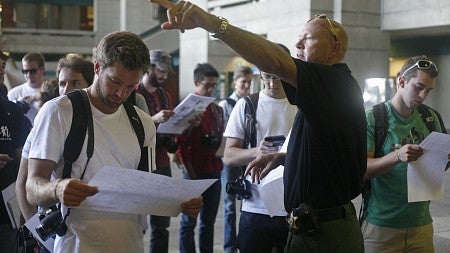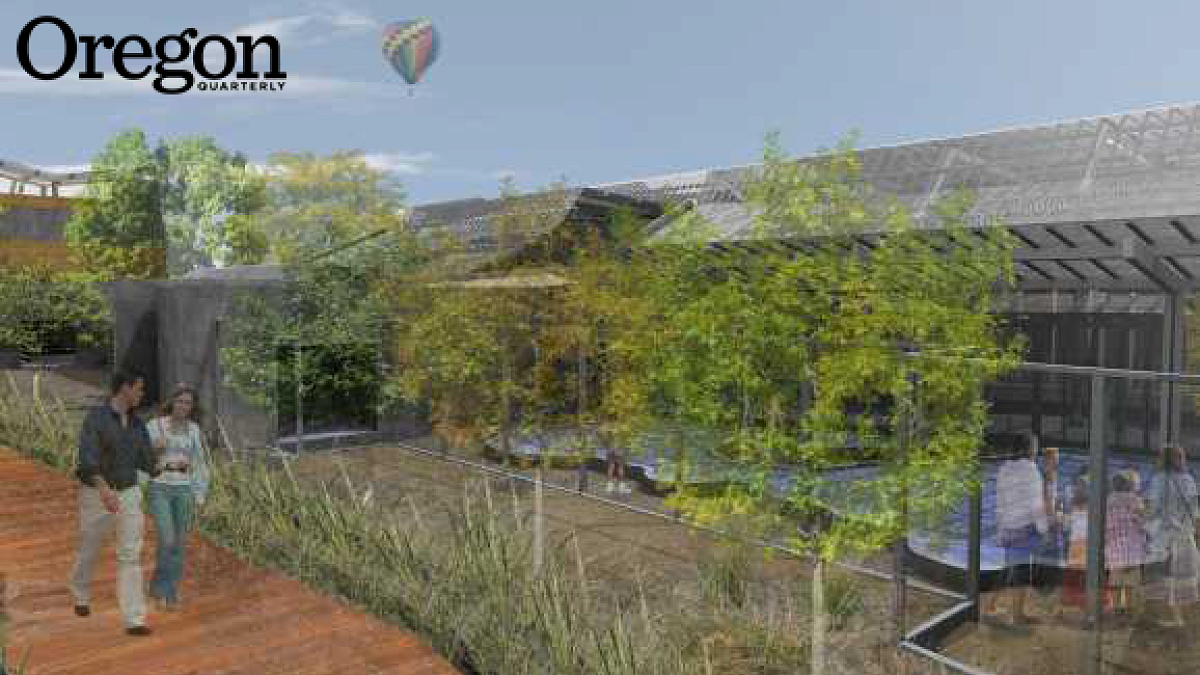Here’s an idea that would never work:
Recruit several professors from various University departments to gear existing courses toward real-world projects in one specific city, all in the same academic year. Convince the city’s officials to plan their projects in ten-week segments so that students produce workable design ideas within the frenetic timeframe of an academic term. Make sure city officials understand they’re part of an experiment that might very well fail. And get them to pay for it.
Marc Schlossberg, associate professor of planning, public policy and management (PPPM), calls this “the founding story” of Sustainable City Year, and if he’s able to tell it with a straight face, it’s because, well, it worked. It probably helped to offer it as a freebie the first time around. In any event, when Schlossberg and his UO coconspirators—whom he describes as “a few faculty members motivated by the urgency of meeting environmental challenges”—approached Gresham city manager Erik Kvarsten ’82 with their idea, Kvarsten didn’t kick them out of his office. Rather, he and Gresham’s department heads knew a good opportunity when they saw one and quickly lined up a slate of nine projects for the UO participants to work on.

Back to 2009–10, Sustainable City Year’s first year, Gresham’s projects ranged from the earthly (a new city hall) to the ethereal (a light-rail station that attracts commuters “with the dynamic qualities of sun, wind, and water”—to quote the SCI website, sci.uoregon.edu). Sixteen faculty members from PPPM, architecture, arts and administration, and landscape architecture devoted nineteen courses during the academic year to tackle the projects. In so doing, they unleashed a swarm of 350 energetic, idealistic students into Gresham’s streets and administrative offices: “a few hundred twenty-somethings,” as Schlossberg puts it, “hungry for doing good” and “desperate to make a difference.”
Kvarsten still remembers them “going out en masse and engaging residents” to learn what they wanted, and “interact[ing] with senior project managers, facilities managers . . . the folks who were doing the work.” The students’ level of interaction with city staff members and residents, he says, went far beyond what a consultant would have done.
One architecture class produced six possible redevelopment proposals for Gresham’s Rockwood area, a low-income neighborhood of vacant storefronts designated for urban renewal in 2003. Kvarsten expects the city will eventually implement a plan incorporating many of the proposals’ shared elements. Rockwood project manager Michael Parkhurst concurs, saying, “People here still refer to the students’ projects for inspiration.”
In fact, Sustainable City Year came through so well for Gresham that the city decided to pay after all. “We thought that the quality of the deliverables justified it,” Kvarsten explains.
Before the “Gresham year” was concluded, many cities were vying for the chance to be next. Salem, the selection for 2010–11, presented fourteen projects, which tapped Sustainable City Year for an even broader range of resources: twenty-eight courses, twenty-five faculty members, ten departments and programs (including journalism, law, and business management in an increasingly interdisciplinary mix), and 500 or so UO students (devoting 80,000 hours to SCY projects, according to a favorable New York Times story). Portland State also got involved, contributing its expertise in civil and environmental engineering. The agreed-to cost for Salem was $345,000.
Broader involvement, same result, beginning with another satisfied city manager, Linda Norris. “Having this kind of research done by all of these incredibly bright people in a short period of time has generated more ideas than we would have generated using our typical methods,” she says. “They have dared to think differently.”
Just consider what Assistant Professor Deni Ruggeri’s landscape architecture class devised for Minto-Brown Island Park, a popular 900-acre recreation area in southwest Salem. What the city wanted was an interpretive trails plan for educating the public about habitat restoration work being done in the park. What it got was a 150-page comprehensive vision that not only included the trail system, but suggested improvements to the restoration work and introduced ideas for urban agriculture and public programs that could take place within the park.

“They produced an enormous amount of work in a short time,” says an impressed Keith Keever ’88, Salem’s parks superintendent, whose staff worked closely with Ruggeri’s nineteen students throughout the term. “It’s refreshing to interact with students and absorb some of their energy and their enthusiasm.”
The story could almost wrap up here, but that would overlook everything else going on with the Sustainable Cities Initiative. SCI’s collaborative faculty research has garnered awards from the American Planning Association and the Partners for Livable Communities. In the policy arena, SCI expertise helped the City of Eugene to draft its Bicycle and Pedestrian Strategic Plan, and the State of Oregon to develop codes for sustainable urban growth.
To better coordinate SCI’s growing number of participating faculty members and departments, Bean authorized funding for SCI to hire an executive director, Robert Liberty ’75, this past January. An Oregon native, Liberty had been serving on the Portland Metro Council since 2005 and brings a wealth of experience addressing smart-growth issues in the state.
Over time, Liberty will need to develop procedures to evaluate Sustainable City Year and SCI’s array of research and policy initiatives. But he won’t fix what ain’t broke. “Part of the genius of the Sustainable Cities Initiative is that it’s based on voluntary collaboration among professors and departments,” he says, “and we don’t want to fiddle with that.”
That should be good news for all the hundreds of enthusiastic students eager to be part of Sustainable City Year for 2011–12. Conveniently, their real-world assignments will be but a carbon-neutral bike ride away from campus—in Springfield.
—By Dana Magliari, MA ’98
Selling It
The dread of having to make a major oral presentation can haunt students for a whole term. Students in Sustainable City Year make presentations to actual paying clients who have contracted for their services. So you’d expect some cases of nerves from the three undergraduate architecture students who presented their design plans for a new police station to a Salem city council subcommittee meeting in February.
If so, it didn’t show. Afterward, they even spoke as if they enjoyed it. “For me,” said Alice Peterson, “it was really great [to] see who you’re designing for, and listen to their goals and their needs for a building.”
But what about all the scrutiny from, among others, the chief of police?
“It’s great to get that [kind of response] from people,” Dustin Locke insisted. “They really want to see their ideas happen in your design. So they are very critical and are willing to come straight forward and tell you what they think, which is great.”
“They’re looking for what you can provide,” added William Smith. “And it’s very important that we experience that in school, because once we get out there, clients want what we say we’re going to give them.”
Associate Planning Professor Marc Schlossberg, whose Hendricks Hall office is cluttered with maps and charts created by students for just such presentations, calls this face-to-face experience with clients “fantastic.” In his own classes, he has students give two-minute presentations, with the idea that in the professional world, that’s all the time they’ll have to sell their ideas.
He even makes them dress up for the occasion
—DM


